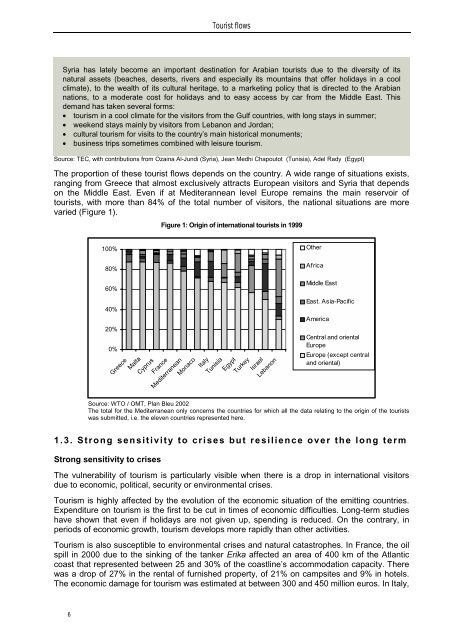dossier sur le tourisme et le développement durable
dossier sur le tourisme et le développement durable
dossier sur le tourisme et le développement durable
You also want an ePaper? Increase the reach of your titles
YUMPU automatically turns print PDFs into web optimized ePapers that Google loves.
6<br />
Tourist flows<br />
Syria has lately become an important destination for Arabian tourists due to the diversity of its<br />
natural ass<strong>et</strong>s (beaches, deserts, rivers and especially its mountains that offer holidays in a cool<br />
climate), to the wealth of its cultural heritage, to a mark<strong>et</strong>ing policy that is directed to the Arabian<br />
nations, to a moderate cost for holidays and to easy access by car from the Midd<strong>le</strong> East. This<br />
demand has taken several forms:<br />
• tourism in a cool climate for the visitors from the Gulf countries, with long stays in summer;<br />
• weekend stays mainly by visitors from Lebanon and Jordan;<br />
• cultural tourism for visits to the country’s main historical monuments;<br />
• business trips som<strong>et</strong>imes combined with <strong>le</strong>i<strong>sur</strong>e tourism.<br />
Source: TEC, with contributions from Ozaina Al-Jundi (Syria), Jean Medhi Chapoutot (Tunisia), Adel Rady (Egypt)<br />
The proportion of these tourist flows depends on the country. A wide range of situations exists,<br />
ranging from Greece that almost exclusively attracts European visitors and Syria that depends<br />
on the Midd<strong>le</strong> East. Even if at Mediterannean <strong>le</strong>vel Europe remains the main reservoir of<br />
tourists, with more than 84% of the total number of visitors, the national situations are more<br />
varied (Figure 1).<br />
100%<br />
80%<br />
60%<br />
40%<br />
20%<br />
0%<br />
Greece<br />
Malta<br />
Cyprus<br />
France<br />
Figure 1: Origin of international tourists in 1999<br />
Mediterranean<br />
Monaco<br />
Italy<br />
Tunisia<br />
Egypt<br />
Turkey<br />
Israel<br />
Lebanon<br />
Other<br />
Africa<br />
Midd<strong>le</strong> East<br />
East. Asia-Pacific<br />
America<br />
Central and oriental<br />
Europe<br />
Europe (except central<br />
and oriental)<br />
Source: WTO / OMT, Plan B<strong>le</strong>u 2002<br />
The total for the Mediterranean only concerns the countries for which all the data relating to the origin of the tourists<br />
was submitted, i.e. the e<strong>le</strong>ven countries represented here.<br />
1.3. Strong sensitivity to crises but resilience over the long term<br />
Strong sensitivity to crises<br />
The vulnerability of tourism is particularly visib<strong>le</strong> when there is a drop in international visitors<br />
due to economic, political, security or environmental crises.<br />
Tourism is highly affected by the evolution of the economic situation of the emitting countries.<br />
Expenditure on tourism is the first to be cut in times of economic difficulties. Long-term studies<br />
have shown that even if holidays are not given up, spending is reduced. On the contrary, in<br />
periods of economic growth, tourism develops more rapidly than other activities.<br />
Tourism is also susceptib<strong>le</strong> to environmental crises and natural catastrophes. In France, the oil<br />
spill in 2000 due to the sinking of the tanker Erika affected an area of 400 km of the Atlantic<br />
coast that represented b<strong>et</strong>ween 25 and 30% of the coastline’s accommodation capacity. There<br />
was a drop of 27% in the rental of furnished property, of 21% on campsites and 9% in hotels.<br />
The economic damage for tourism was estimated at b<strong>et</strong>ween 300 and 450 million euros. In Italy,
















